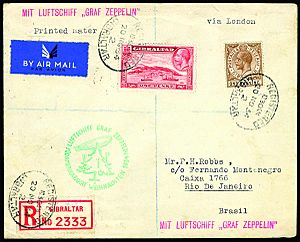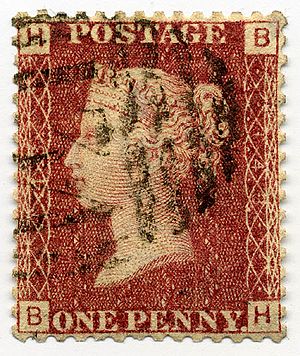Philately facts for kids

Philately is the study of stamps, postal history, and other related items. It's more than just collecting stamps. Philately means learning about stamps, how they are made, and their history. You can be a philatelist even without owning many stamps, especially if they are very rare or found only in museums.
Contents
What Is Philately?
Traditional philately focuses on the technical details of stamps. This includes how stamps are made and how to identify them.
Here are some things philatelists study:
- How stamps are designed.
- The type of paper used, like if it has watermarks.
- The way stamps are printed (like engraving or typography).
- The gum on the back of the stamp.
- How stamps are separated, like with perforations (the little holes).
- Any extra printing on the stamp, called overprints.
- Special security marks or perfins (perforated initials).
- How to spot fake stamps.
Different Kinds of Philately
Philately has many interesting branches, each focusing on a different part of stamps or mail.
Thematic Philately: Stamps with Stories
Thematic philately is about what pictures are on stamps. There are hundreds of popular themes. You can find stamps with birds, ships, famous people, maps, airplanes, or even insects! Sometimes, stamps even show other stamps. Philatelists also look for design mistakes or changes, like when cigarettes were removed from pictures on some United States stamps.
Postal History: The Journey of Mail
Postal history looks at how mail systems work and have worked over time. This includes studying postmarks, post offices, and how letters travel from one person to another. A famous example is the Pony Express. This was the fastest way to send letters across the United States for a short time. Letters proven to have been sent by the Pony Express are very valuable to collectors.
Aerophilately: Mail by Air
Aerophilately is a special part of postal history that studies airmail. Philatelists have watched how mail transport by air has grown since the very beginning. They study everything about airmail services.
Astrophilately: Space Mail
Astrophilately is another branch of postal history. It focuses on stamps and envelopes that are connected to outer space. This includes mail sent from space or related to space missions.
Postal Stationery: Pre-Printed Mail
Postal stationery includes items like stamped envelopes, postal cards, and aérogrammes. These items already have an embossed or imprinted stamp on them, showing that postage has been paid.
Erinnophilia: Not Quite Stamps
Erinnophilia is the study of things that look like stamps but are not used for postage. Examples include Easter Seals and Christmas Seals, which are often used for charity.
Youth Philately: Fun for Kids
Youth philately focuses on stamps with colorful characters or themes that appeal to younger collectors. Its main goal is to get kids interested in the fun hobby of stamp collecting.
Tools for Philatelists
Philatelists use special tools to help them study stamps carefully.
- Stamp tongs are like small tweezers. They help you pick up stamps safely without touching them with your fingers.
- A strong magnifying glass helps you see tiny details on the stamp.
- A perforation gauge (also called an odontometer) measures the size of the perforations (holes) around the stamp.
Finding watermarks is important. You can sometimes see them by holding the stamp up to the light. If not, a special watermark fluid can be used to reveal the mark.
Other common tools include stamp catalogs (books that list stamps), stamp stock books (albums to store stamps), and stamp hinges (small pieces of paper to attach stamps to an album page).
Philatelic Clubs and Groups
Many philatelic organizations were created soon after people started collecting stamps. These include local, national, and international clubs. Collectors meet in these groups to share their hobby and learn from each other. One well-known group is the American Philatelic Society.
See also
 In Spanish: Filatelia para niños
In Spanish: Filatelia para niños



